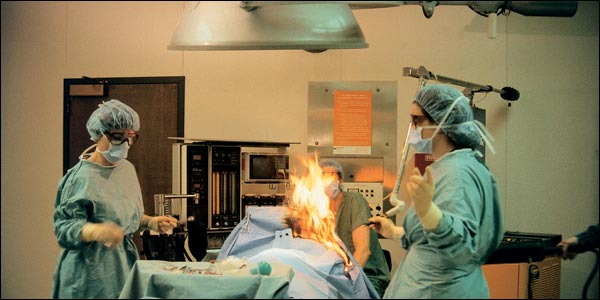Fire in the Hole!—An OR Fire
Mehta SP, Domino KM. Fire in the Hole!—An OR Fire. PSNet [internet]. Rockville (MD): Agency for Healthcare Research and Quality, US Department of Health and Human Services. 2015.
Mehta SP, Domino KM. Fire in the Hole!—An OR Fire. PSNet [internet]. Rockville (MD): Agency for Healthcare Research and Quality, US Department of Health and Human Services. 2015.
The Case
A patient was taken to the operating room (OR) to undergo a planned laparoscopic subtotal colon resection for a biopsy-proven adenocarcinoma. After resecting the segment of the colon where the tumor was located, the surgeon realized that he had accidentally lacerated the bladder. The laceration was located and sutured without difficulty, and the decision was made to irrigate the bladder to ensure its wall was intact. As the surgeons went about the task of bowel re-anastomosis (reconnection) in the darkened laparoscopic suite, the nurses set up the bladder irrigation equipment and began to flush the bladder with warm saline. None of the OR staff noticed that in the course of setting up the irrigation equipment, the circulating nurse had hung the large 3-liter bag of irrigating solution from the handle of the anesthesiologists' accessory "slave" monitor, directly above the major transformer that powers the device. As the procedure continued, the bag of saline began to drip directly into the power inverter. Suddenly, sparks and flames began shooting from the monitor tower, and the OR quickly filled with black smoke.
At this hospital, the OR staff conducted daily safety huddles and held timeouts before every procedure, both of which included physical verification and verbalization of fire safety measures available. In this case, the preoperative timeout included all members of the operating team agreeing on the current procedure's fire risk and the nurse verifying and verbalizing the location of the nearest fire extinguisher next to the OR door. The OR team immediately put this training into action. The anesthesiologist quickly shut down the purified oxygen, while the surgical team attempted to halt the procedure before they lost all visualization. The scrub nurse activated the overhead lights, grabbed the fire extinguisher near the room entrance, and was able to quickly put out the fire. Once it was extinguished and the monitor setup examined, the culprit was identified: the leaking bag of saline into the active transformer. Fortunately, neither the patient nor any member of the operating staff was injured as a result of this incident. The damaged equipment was promptly replaced and the procedure concluded without further incident.
The Commentary
Operating room (OR) fires are extremely rare, with a yearly frequency estimated at 200–240 nationally (1), which translates into an estimated incidence of 0.32 per 100,000 operations.(2) Many anesthesiologists and surgeons remain unaware of fire risks in the OR, despite recent attention by the Anesthesia Patient Safety Foundation (APSF) (3), the American Society of Anesthesiologists (ASA) (4), the American College of Surgeons (5), and the Food and Drug Administration.(6)
The Fire Triad
Fire requires the presence of three components, known as the "fire triad" (4): (i) an ignition source, (ii) an oxidizer, and (iii) fuel (Figure). The electrocautery (Bovie) is the most common ignition source of OR fires, and other sources include lasers, fiber optic light cables, argon beam coagulators, heated probes, drills and burrs, and defibrillator paddles or pads.(4) In a report of 70 OR fires in the state of Pennsylvania, the most common ignition source was the electrocautery (58%), followed by a fiber optic light cable (38%) and a laser (3%).(2) Oxidizers in the OR typically include oxygen or nitrous oxide.(4) Both of these agents increase the likelihood and intensity of combustion in the surgical field in a concentration-related manner. Fuel sources include, but are also not limited to, endotracheal tubes, sponges, drapes, gauze, alcohol-containing prep solutions, solutions containing other volatile compounds such as ether or acetone, oxygen masks, nasal cannula, the patient's hair, dressings, ointments, surgical gowns, gastrointestinal tract gases, blankets, suction catheters, flexible endoscopes, fiber optic cable coverings, gloves, and packaging materials.(4) Pooling of alcohol-containing prep solutions in the drapes has been implicated in a number of cautery-induced fires. However, the use of supplemental oxygen in the presence of an electrocautery is the predominant cause in most OR fires, since combustion is markedly enhanced in an oxygen-enriched environment.
OR Fires in Malpractice Claims
Using the Anesthesia Closed Claims database, we reviewed 103 closed malpractice claims for OR fires against anesthesiologists, all of which concerned on patient fires resulting in patient injury.(7) The electrocautery was the ignition source in the vast majority of these claims (n=93, 90%). The other ignition sources were lasers (n=9) and a defibrillator (n=1). The percentage of OR fires increased over time, from less than 1% of all surgical anesthesia claims in 1985–1994 to 4.4% of all surgical anesthesia claims between 2000–2009.(7) This trend was especially pronounced among claims for monitored anesthesia. Approximately 83% of the fires occurred during sedation for sedation procedures with use of supplemental oxygen in high-risk head, neck, or upper chest procedures.(7) Oxygen delivery devices (e.g., facemasks, nasal cannulae) and surgical drapes typically served as fuel sources. Alcohol-containing prep solutions that pooled into the drapes were important factors in a minority of claims.(7) The remainder of fires (17%) occurred during general anesthesia, most often with an endotracheal tube cuff rupture or cuff leak, during oral, pharyngeal, or tracheal surgery.(7)
Fire in the Presented Case
The ignition source in the presented case (i.e., the monitor power transformer) is extremely rare. This unusual case reminds clinicians that electronic equipment of all types can serve as an ignition source—not just the electrocautery, fiber optic light sources, or lasers. A root cause analysis of fires in Indian hospitals found that air conditioners, ventilators, incubators, and electrical short circuits were the most common ignition sources, with most fires occurring in oxygen-enriched environments (e.g., the OR, intensive care unit, neonatal intensive care unit).(8)
While most OR fires in the United States are on-the-patient fires (Figure), the above case also demonstrates that non-patient OR fires can occur in this day and age, despite current safety guidelines directed at the most common sources of OR fires. The type of ignition source may result in smoke in the OR and potential harm to patients and health care providers. Root cause analyses are especially important to determine the systems issues behind unusual causes of OR fires. Clearly, the irrigation solution should never been hung above any type of transformer or electronic equipment, and a root cause analysis would likely have called out this important educational issue for circulating registered nurses (RNs). An intravenous (IV) line pole is normally used to hang IV and irrigation solutions: perhaps it was not available in the OR or the anesthesia provider did not want a heavy 3-liter irrigation bag hanging from the same poles being used for the IV fluids (which would have made it hard to raise the IV bag to hasten IV fluid delivery to the patient).
The OR was darkened to enhance the surgeon's visualization of intra-abdominal structures during laparoscopic surgery. However, darkness is a potential safety hazard for patient care, since this makes it harder for team members to read medication labels (causing incorrect administration of medications), observe fluid administration rates, and in this case, rapidly detect leaking saline irrigation fluid. The case also illustrates the importance of each team member in rapidly responding to treat an OR fire. However, the safest approach to OR fires is prevention, especially critical for on-the-patient fires to prevent patient injury.
Prevention and Treatment
OR fires are preventable. All OR personnel must be very aware of the fire triad and use techniques to minimize an oxidizer-enriched atmosphere and safely manage both ignition sources and fuels (Table). In addition, all OR personnel need to participate in practice drills in which they treat OR fires. Recognition of unusual fire sources and identifying ways to mitigate risk, such as safe use of OR electrical and monitoring equipment and correction of systems factors (e.g., excessively dark ORs, leaking irrigation fluid, perhaps lack of IV poles in this case) are also important.
As most OR fires are on-the-patient fires, OR personnel need to recognize that the risk of ignition and speed of fire propagation increase as oxygen concentration increases.(9) Not all patients require supplemental oxygen during sedation. If heavy sedation with supplemental oxygen is required, the ASA advisory recommends general anesthesia with an endotracheal tube or laryngeal mask airway.(4) Oxygen buildup should be prevented by allowing adequate venting of drapes and by shutting off oxygen 3–5 minutes prior to use of electrocautery. Good communication between surgeon and anesthesiologist regarding the timing of use of the electrocautery is key, to allow adequate time for the oxygen to be eliminated from the surgical field. In oxygen-dependent patients, the electrocautery should be avoided at the time of the tracheostomy. A standard fire checklist should be available or added to existing operating room checklists, and it should be implemented prior to the start of the case to discuss strategies to reduce potential fire hazards during high-risk surgery (i.e., proximity of an ignition source and an oxidizer-enriched atmosphere).(5) New technologic advances such as a carbon dioxide fire prevention device around the electrocautery may help reduce the risk in high fire-risk surgical procedures.(10)
Take-Home Points
- OR fires are preventable. Prevention is especially essential to reduce risk of patient injury in on-the-patient fires.
- All OR personnel must recognize the fire triad in the OR (i.e., oxidizer, ignition source, and fuel), including the critical role of oxygen by open delivery systems during electrocautery use to develop systems approaches to prevent OR fires.
- While most OR fires are on-the-patient fires, OR personnel should also recognize the fire triad to prevent and treat an OR with unusual sources of OR fires.
- Preoperative checklists for high fire-risk procedures, team communication patterns, fire drills, and other systems approaches as suggested by root cause analyses should be incorporated to reduce fire risk in the OR.
Sonya P. Mehta, MD, MHS Staff Anesthesiologist Group Health Cooperative Seattle, WA
Karen B. Domino, MD, MPH Professor & Vice Chair for Clinical Research, Anesthesiology, and Pain Medicine Adjunct Professor, Neurological Surgery University of Washington Seattle, WA
References
1. ECRI Institute. Surgical fire prevention: educational resources and custom consulting services. [Available at]
2. Clarke JR, Bruley MK. Surgical fires: trends associated with prevention efforts. PA-PSRS Patient Saf Advis. 2012;9:130-135. [Available at]
3. Anesthesia Patient Safety Foundation, Fire Safety Video. [Available at]
4. Apfelbaum JL, Caplan RA, Barker SJ, et al; American Society of Anesthesiologists Task Force on Operating Room Fires. Practice advisory for the prevention and management of operating room fires: an updated report by the American Society of Anesthesiologists Task Force on Operating Room Fires. Anesthesiology. 2013;118:271-290. [go to PubMed]
5. Ziewacz JE, Arriaga AF, Bader AM, et al. Crisis checklists for the operating room: development and pilot testing. J Am Coll Surg. 2011;213:212-217. [go to PubMed]
6. Preventing Surgical Fires: FDA Safety Communication. Silver Spring, MD: United States Food and Drug Administration; October 13, 2011. [Available at]
7. Mehta SP, Bhananker SM, Posner KL, Domino KB. Operating room fires: a closed claims analysis. Anesthesiology. 2013;118:1133-1139. [go to PubMed]
8. Chowdhury K. Fires in Indian hospitals: root cause analysis and recommendations for their prevention. J Clin Anesth. 2014;26:414-424. [go to PubMed]
9. Culp WC Jr, Kimbrough BA, Luna S. Flammability of surgical drapes and materials in varying concentrations of oxygen. Anesthesiology. 2013;119:770-776. [go to PubMed]
10. Culp WC Jr, Kimbrough BA, Luna S, Maguddayao AA. Mitigating operating room fires: development of a carbon dioxide fire prevention device. Anesth Analg. 2104;118:772-775. [go to PubMed]
Table
Table. Prevention of Operating Room Fires.(4)
| General Guidelines—Fire Triad | Specific Recommendations |
|---|---|
| Minimize an oxidizer-enriched atmosphere |
|
| Safely manage ignition sources |
|
| Safely manage fuels |
|
Figure
Figure. A staged operating room fire scene. (Photo Source: ECRI Institute).




